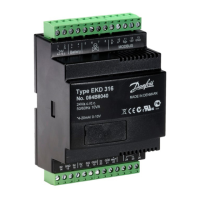What to do if my Danfoss EKD 316 shows a battery alarm?
- AAntonio BatesJul 26, 2025
If you see a battery alarm on your Danfoss Controller, check that the battery voltage is at the nominal voltage, as indicated by alarm message A44.

What to do if my Danfoss EKD 316 shows a battery alarm?
If you see a battery alarm on your Danfoss Controller, check that the battery voltage is at the nominal voltage, as indicated by alarm message A44.
What to do if my Danfoss EKD 316 displays a pressure transmitter outside range?
If your Danfoss Controller indicates that the pressure transmitter is outside of its specified range (E20), check the pressure transmitter itself, the connections at terminals 14-15, and the pressure level.
Why are all the light emitting diodes flashing on my Danfoss Controller?
If all the light emitting diodes are flashing on your Danfoss Controller, this could indicate a sensor fault. Specifically, it might be E24, indicating an S2 sensor fault, or E25, indicating an S4 sensor fault.
What to do if my Danfoss Controller displays battery alarm due to low voltage?
If your Danfoss Controller shows a battery alarm due to no voltage or too low voltage, indicated by alarm message A44, check the battery voltage to ensure it is at the nominal voltage.
| Brand | Danfoss |
|---|---|
| Model | EKD 316 |
| Category | Controller |
| Language | English |
Details the application of the EKD 316 controller in water chillers using direct expansion.
Controller searches for minimum stable superheat between upper and lower bounds.
Sets a maximum operating pressure to reduce compressor strain.
Allows EKD 316 to operate independently with one temperature and one pressure transducer.
Valve can be controlled manually via MODBUS or analog signal.
Opens valve quickly on compressor start to prevent low suction pressure.
The relay for the alarm function is an alternating relay.
Details essential connections for power, battery, and stepper motor output.
Describes connections for sensors, pressure transmitters, and analog signals.
Controls superheat using one pressure and one temperature sensor.
Controller receives analog signals to control valve opening degree.
Addresses the 'Sleeping Evaporators' phenomena in parallel systems.
Explains the function of the alternating alarm relay.
Describes operating the controller using an external display.
Details communication via MODBUS RTU protocol for data exchange.
Notes on connecting power supply and potential issues with shared supplies.
Checks for resistance and phase current for the stepper motor connection.
Describes the function of the alarm relay contact.
Explains the connection and function of the battery backup for power failure.
Crucial placement of the S2 sensor for optimal superheat control.
Details different S2 sensor types and their suitability for pipe materials.
Provides diagrams for correct S2 sensor placement based on pipe diameter.
Defines essential settings like refrigerant type and transducer range before use.
Explains the two superheat regulation modes: MSS and Load Defined.
Details the two methods: Minimum Stable Superheat (MSS) and Load Defined Superheat.
Algorithm aims for lowest stable superheat within defined bounds.
Controls maximum operating pressure to reduce compressor strain.
Limits evaporator pressure to prevent compressor strain.
Covers setting the range for the pressure transmitter, default AKS 32R.
Explains how to set minimum and maximum values for the pressure transmitter.
Traditional PI control with Kp and Tn factors for regulation.
Uses outer and inner loops for improved regulation, especially for water chillers.
Provides guidance on selecting control loop types for air coolers and water chillers.
Manual valve operation via external display or MODBUS is detailed.
Allows forcing ETS output and alarm relay outputs for service.
Sets the valve's opening degree manually via parameter 045.
Controls valve opening degree using 0-20 mA or 0-10 V external signals.
Defines signal ranges for external control of valve opening degree.
Explains Kp factor, Kp min, and their impact on superheat stability.
Describes how proportional gain varies with superheat reference.
Procedure to prevent slow valve opening during startup by providing initial opening.
Lists common fault messages, possible causes, and remedies for controller alarms.
Covers units, signal correction for sensors, start/stop, alarm, and battery monitoring.
Details parameters for superheat regulation, including Kp, Tn, SH references, and MOP.
Includes valve definition, steps, speed, backlash, unit address, and refrigerant settings.
Covers normal display, reference units, and signal correction for sensors.
Details start/stop inputs, alarm functions, and battery monitoring.
Explains parameters for superheat control like Kp, Tn, SH references, and MOP.
Includes valve definition, miscellaneous settings, and communication parameters.
Covers manual control of outputs and the ETS valve.
Details pressure transmitter range, control algorithm, and refrigerant selection.
Lists values readable from the controller for service and diagnostics.
